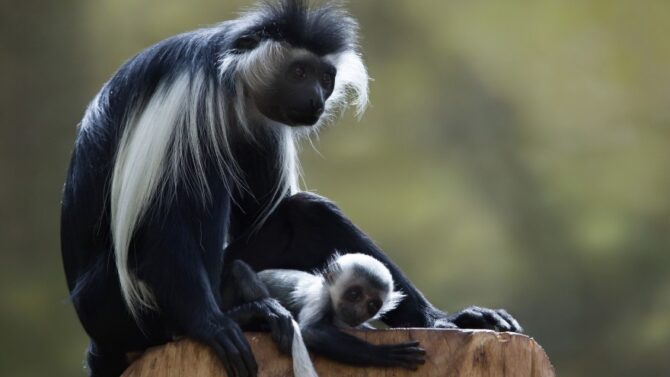
From its thriving arts scenes to its appetizing cuisine and over forty local breweries, the state offers something to people with various interests to enjoy.
For nature enthusiasts, Cincinnati offers abundant wildlife species, including raccoons, squirrels, snakes, opossums, bats, foxes, and even monkeys.
While there are no native monkeys in Cincinnati, some non-native monkeys inhabit certain areas within the city’s supportive habitats.
This includes the black howler monkey, the black-and-white colobus monkey, the white-faced saki, and the Angolan colobus monkey.
This article will take a close look at these species and share some interesting facts about them.
Why Is Cincinnati a Good Habitat for Monkeys?
Cincinnati lies at the southern border of the humid continental climate zone bounding the humid subtropical climate zone.
The subtropical climate of this Ohioan city is similar to the climates of Africa and South America, where the earlier mentioned monkey species are endemic.
However, that’s not all.
In captivity, these monkeys enjoy a diet of leaves, fruits, seeds, and other nutritional items from the trees and vegetative canopies within the city’s zoos.
This ensures the monkeys grow in a comfortable environment and meet their dietary needs, despite not being native to Cincinnati.
4 Monkey Species in Cincinnati
1. Black Howler Monkey
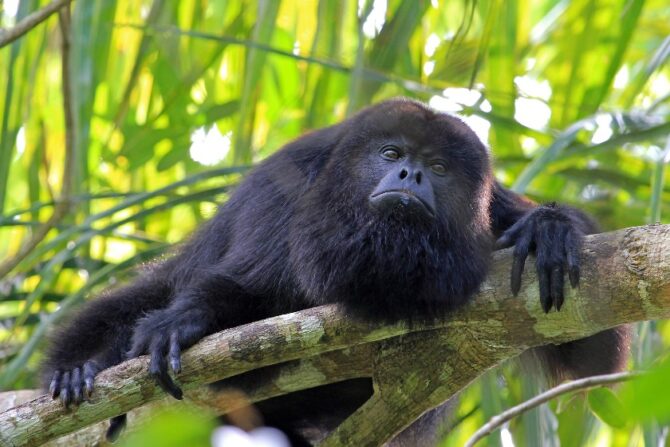
Scientific Name: Alouatta caraya
Conservation Status: Near threatened
Length: 24 to 26 inches (males) and 20 inches (females)
Weight: 32.5 lbs (males) and 16 lbs (females)
Lifespan: 15 to 20 years
Range: Regions in Central and South America
Black howler monkeys mainly inhabit the tropical South American rainforests in Brazil, Uruguay, Paraguay, northern Argentina, and eastern Bolivia.
However, the Cincinnati Zoo & Botanical Garden on 3400 Vine Street cares for these monkeys and allows Cincinnati’s inhabitants to observe them up close.
Black howler monkeys are one of the few primates that exhibit sexual dimorphism—males and females show distinct physical differences.1
Adult male black howlers are characterized by their black coat, while adult females (and juveniles of both sexes) have a blonde or golden coat.
That’s why some refer to the monkey as the black-and-gold howler.
They also have a prehensile tail without hair on the bottom side, which they use for grasping while moving around.
They also have five-toed, grasping feet and move slowly using a quadrupedal mode of locomotion.
Although the International Union for Conservation of Nature (IUCN) lists the black howler as “near threatened,” this monkey can adapt to various forest environments within its geographical range.
Black howlers, like other howler monkeys, spend most of their day feasting on leaves in the treetops.
Black howlers are so named for their loud howls, which they use to defend their territory.
Under certain conditions, the howl of a black howler can be heard from about 3 miles away.
2. Black-and-White Colobus Monkey
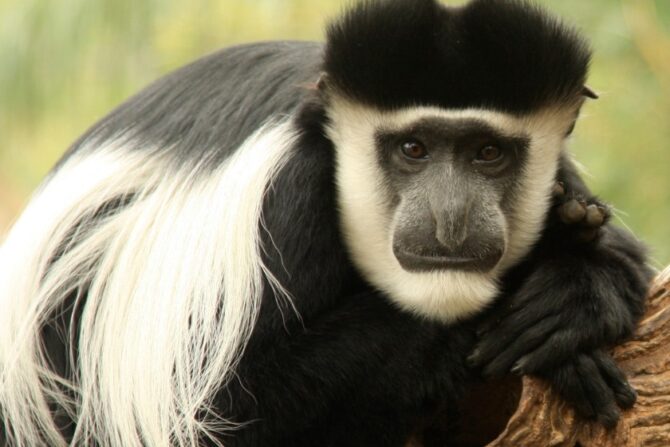
Scientific Name: Colobus guereza
Conservation Status: Not Extinct
Length: 17 to 28 inches
Weight: 18 to 30 lbs
Lifespan: 20 years in the wild and 35 years in captivity
Range: Central and Eastern Africa
Black-and-white colobus monkeys are Old World monkeys indigenous to Central and Eastern Africa.
It’s hard to tell how many of these monkeys are in Cincinnati.
However, we know a good number of them are kept in the Cincinnati Zoo & Botanical Garden.
While there are five species of black-and-white colobus monkeys, they are generally characterized by their black fur with white features.
Black-and-white colobus monkeys are 17 to 28 inches tall.
They also have a white tail that’s 20 to 40 inches long, which is longer than their heads and bodies combined.2
These monkeys are mostly black but have white fur surrounding their face and long, u-shaped white fur running along the sides of their body.
They also have small thumbs that allow them to form a hook-like grip that aids their swinging while traveling across trees.
This adaptation suits the monkey’s habitat in the wild, where it lives in high-density forests, foraging on leaves, flowers, and fruits.
3. White-Faced Saki
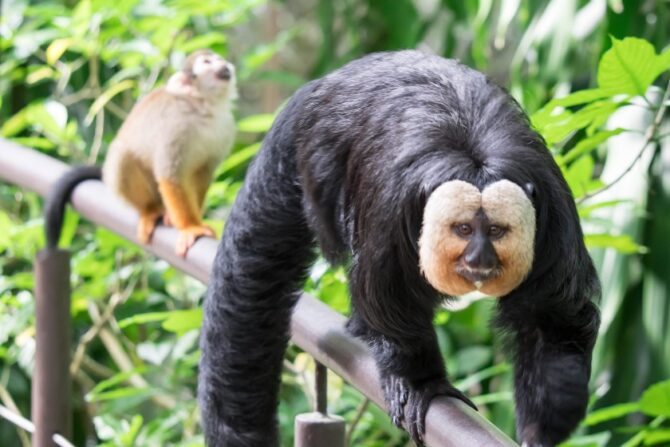
Scientific Name: Pithecia pithecia
Conservation Status: Least concern
Length: 12 to 16 inches
Weight: 4 to 5.2 lbs (males) and 3 to 4.1 lbs (females)
Lifespan: 14 years in their natural habitat and 36 years in captivity
Range: Northern South America
The white-faced saki is a New World monkey species visitors can find in the Cincinnati Zoo & Botanical Garden.
This monkey is native to the regions like French Guiana, Brazil, Guyana, Venezuela, and Suriname.
Like the black howler, the white-faced saki exhibits sexual dimorphism (male and female white-faced sakis look very different).3
However, both sexes of this monkey are generally characterized by their brightly colored face, which may be gold or white.
The white-faced saki’s diet mainly includes nuts, fruits, seeds, and insects.
Little wonder it mostly lives in forests’ understories and lower canopies.
4. Angolan Colobus Monkey
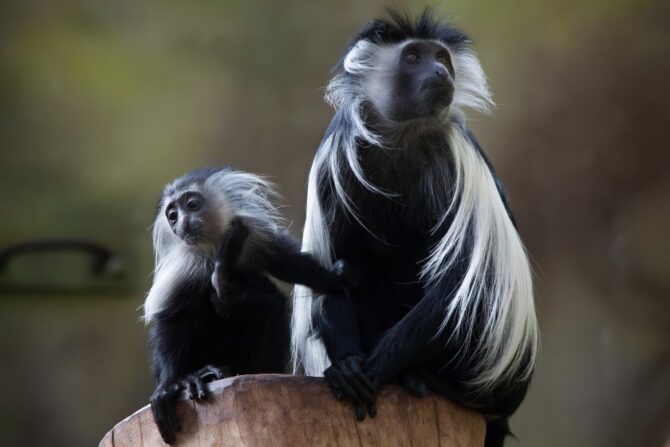
Scientific Name: Colobus angolensis
Conservation Status: Vulnerable
Length: 18 to 28 inches
Weight: 13 to 25 lbs
Lifespan: 18 yrs
Range: Central and Eastern Africa
The Angolan colobus monkey is a species of colobus monkey with a color similar to that of the black-and-white colobus monkey.
As the name implies, Angolan colobus monkeys are native to Angola, although they are rarely seen there.
These monkeys live in dense rainforests in many Central and Eastern African countries.
However, in Cincinnati, the Cincinnati Zoo & Botanical Garden provides a home for them.
Angolan colobus monkeys are very sociable and, like other colobus monkeys, they can live in groups that may reach 100 individuals.
Although Angolan colobus monkeys mainly eat leaves, they will not shy from small quantities of fruit and seeds.
Human Interactions with Monkeys in Cincinnati
Although wild monkeys tend to avoid people, populations or individual monkeys may often venture closer to humans.
However, captive monkeys can become aggressive when interacting with humans, especially when visitors refuse to feed them.
Fortunately, the Cincinnati Zoo & Botanical Garden offers a secure environment to observe these animals up close without getting hurt.
The Environmental Impact of Cincinnati’s Monkey Populations
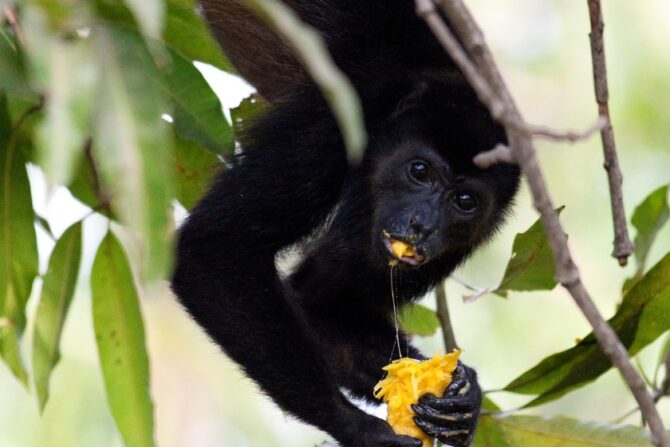
The environmental impact of Cincinnati’s monkeys needs to be more largely assessed.
As of today, monkey populations in the state are relatively small, and their impact is mostly localized.
However, Cincinnati could face major consequences due to the presence of these monkeys, like widespread vegetation loss.
Still, it is worth noting that research into the overall effect on monkey populations within their natural range remains inefficient.
Frequently Asked Questions (FAQs)
Why Is the Cincinnati Zoo Famous?
The repeated mentions of the Cincinnati Zoo & Botanical Garden in this article might spark some curiosity.
This zoo is well-known for its wide diversity of wildlife, including various species of monkeys and apes.
Does the Cincinnati Zoo Have Other Primates?
Monkeys are not the only primates in the Cincinnati Zoo & Botanical Garden.
Other primate species are cared for in this zoo, including the Garnett’s galago, bonobo, some gibbon species, lemurs, orangutans, and gorillas.
Wrapping Up
While Cincinnati might not be home to any monkeys, residents don’t have to travel to the wild to observe these fascinating creatures.
Thanks to the Cincinnati Zoo & Botanical Garden, visitors can safely observe several monkeys in Cincinnati, like the Angolan colobus monkey, black-and-white colobus monkey, white-faced saki, and black howler monkey.


